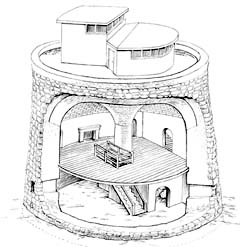
Martello Towers
Carleton Martello Tower National Historic Site
A Solid Presence

The Carleton Martello Tower is just one of over 200 defence towers that the British built worldwide. Between 1796 and 1847, sixteen Martello towers were constructed in British North America.
In an age of smoothbore artillery, these towers were seen as an effective and affordable way to protect coastal areas from enemy attack.
But what makes a tower a Martello tower? Martello towers, whether in Canada, England, or Mauritius, all had certain features in common. For instance, these structures were circular in shape with a flat roof on which artillery could be mounted. The towers were accessible through a doorway in the second storey, or barrack floor. The ground floor had storage space and a gunpowder magazine. The key feature was a round, brick pillar that supported both the roof and the arched brick ceiling which, along with the thick walls, was designed to absorb artillery fire. Based on these elements, it is easy to see why Martello towers gained a reputation for strength.
It is believed that Martello towers were named after a place in Corsica called Cape Mortella (the "o" and the "a" would eventually be transposed). It was there, in 1794, that the Royal Navy attacked a circular stone tower being held by the French. Overtaking the tower was no easy task, and the strength of that stone tower made a lasting impression on the British.
When Napoleon was threatening to invade Great Britain some ten years later, Britain's faith in the Martello tower design was shown with the addition of over 100 of them on England's southeast coast.
Next part: The 1840's to Confederation
- Date modified :